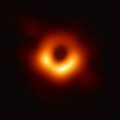| IRAS 13224-3809 | |
|---|---|
 DESI Legacy Surveys image of IRAS 13224-3809 | |
| Observation data (J2000 [1] epoch) | |
| Constellation | Centaurus [2] |
| Right ascension | 13h 25m 19.38s [1] |
| Declination | −38° 24′ 52.61″ [1] |
| Redshift | 0.06580 ± 0.00018 |
| Distance | 1 billion light-years [3] |
| Apparent magnitude (V) | 13.80 [4] |
| Other designations | |
| 2MASX J13251937-3824524; 2MASS J13251937-3824526; GSC 07787-00931; IRAS F13224-3809; PGC 88835; 1RXS J132519.4-382445; WISE J132519.39-382452.5; Gaia DR2 6162481890199388928 [1] | |
IRAS 13224-3809 is a highly active and fluctuating Seyfert 1 galaxy in the constellation Centaurus [2] about 1 billion light-years from Earth. [3] [5] [6] The galaxy is notable due to its centrally located supermassive black hole that is closely studied by astronomers using x-ray astronomy, particularly X-ray reverberation echo mapping techniques, in an effort to better understand the inner workings, including mass and spin, of black holes. [3] [5]
X-Ray reverberation echo studies of black holes (video; 3:33)
